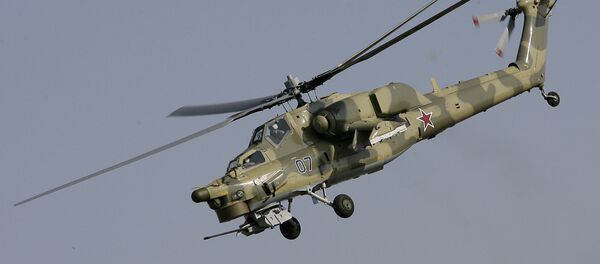A number of Mi-28NEs are currently on combat duty in Iraq and are now being eyed also by Brazil, Vietnam and several North African countries.
The Mi-28NE Night Hunter (NATO reporting name “Havoc”) can be deployed to identify and destroy enemy battle tanks, armored vehicles, personnel, boats, small naval vessels, and low-speed and low-altitude aircraft. It can also be used to destroy protected sites and defense installations.
The Mi-28NE boasts an integrated electronic combat system. Other modifications include: a new main gearbox for transmitting higher power to the rotor; new high-efficiency blades with swept-shaped tips; and an engine fuel injection control system.
The main sensors of the integrated electronic combat system are the microwave radar antenna, mounted above the rotor head, and a forward-looking infrared system.
The system displays the helicopter location on a moving map indicator, and flight, systems and target information on liquid crystal displays. The crew is equipped with night-vision goggles.
The pilot uses a helmet-mounted target designator, which allocates the target to the navigator's surveillance and fire control system. The navigator/weapons officer is then able to deploy guided weapons or guns against the target.
The targeting system follows the direction of the pilot's eyes.
The Mi-28NE Night Hunter is powered by two VK-2500 turboshaft engines each generating maximum take-off power of 2,200hp.
The helicopter can climb at a rate of 13.6m/s and has a service ceiling of 5,600m. The cruise and maximum speeds are 270km/h and 300km/h respectively, while the range is about 435km.
Nearly a dozen countries have shown interest in buying the Night Hunters.
“These are CIS countries, Latin America, Vietnam, Malaysia, Thailand, Bahrain, Iran, Egypt, Algeria and also countries in sub-Saharan Africa, a source at the Defense Ministry’s international cooperation department told Gazeta.ru.

![A Mil Mi-28-NE Havoc [Night Hunter] attack helicopter A Mil Mi-28-NE Havoc [Night Hunter] attack helicopter - Sputnik International](https://cdn1.img.sputnikglobe.com/img/103646/76/1036467672_0:154:3076:1893_600x0_80_0_0_67d898eff33de45cffba0b6953e57074.jpg)

